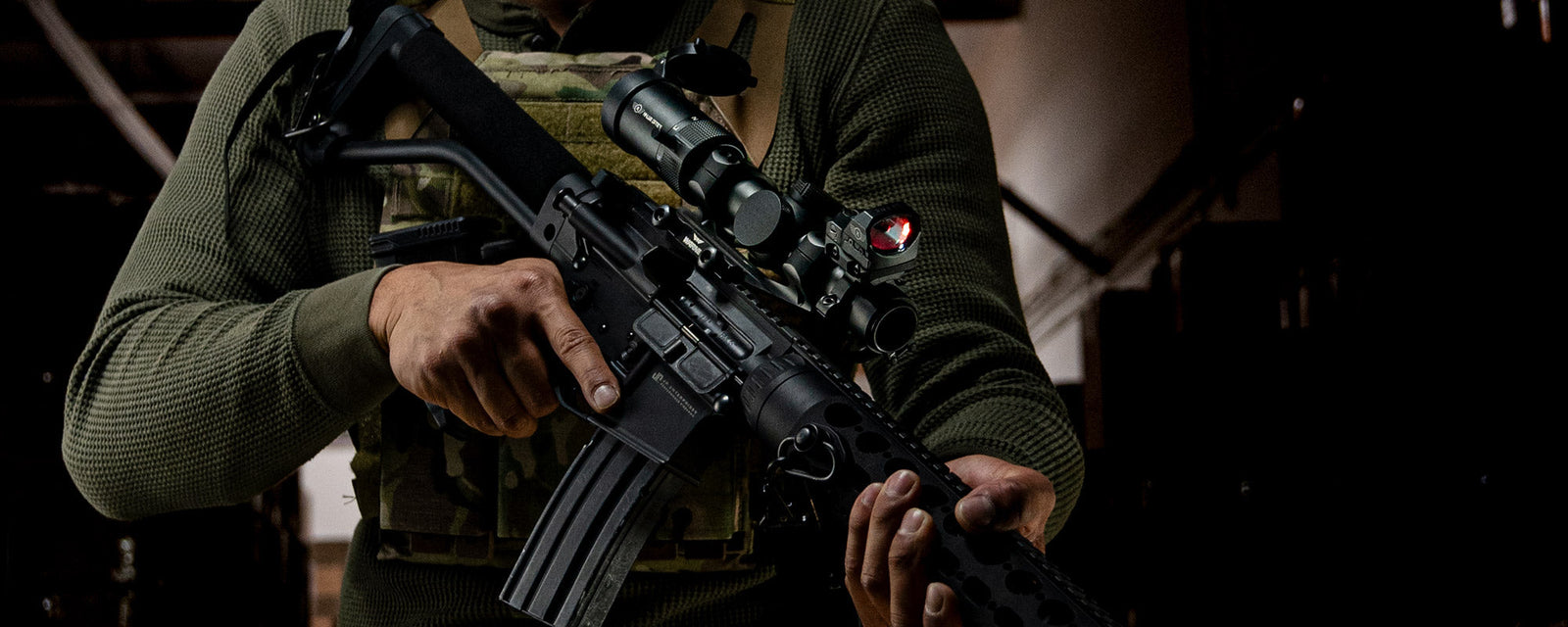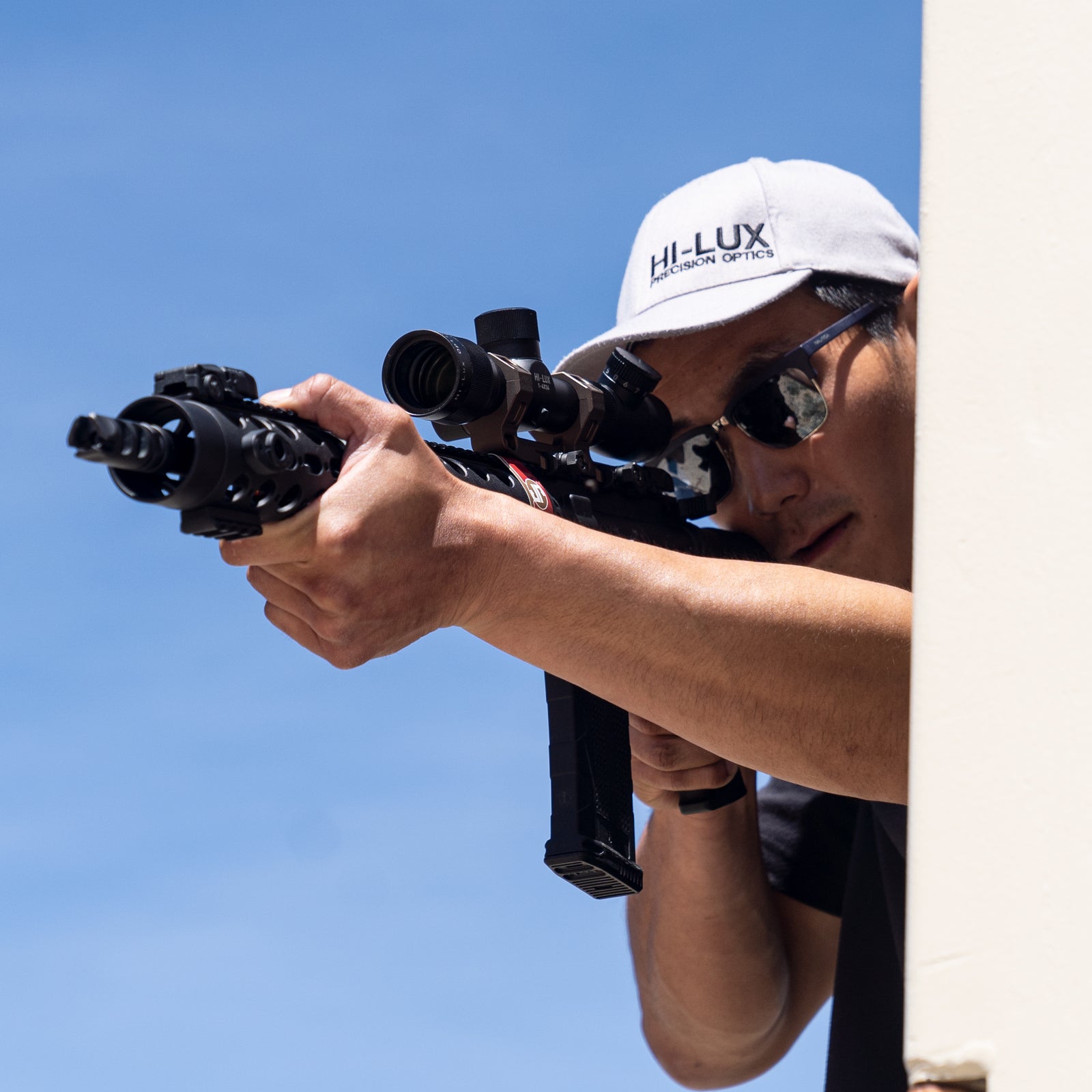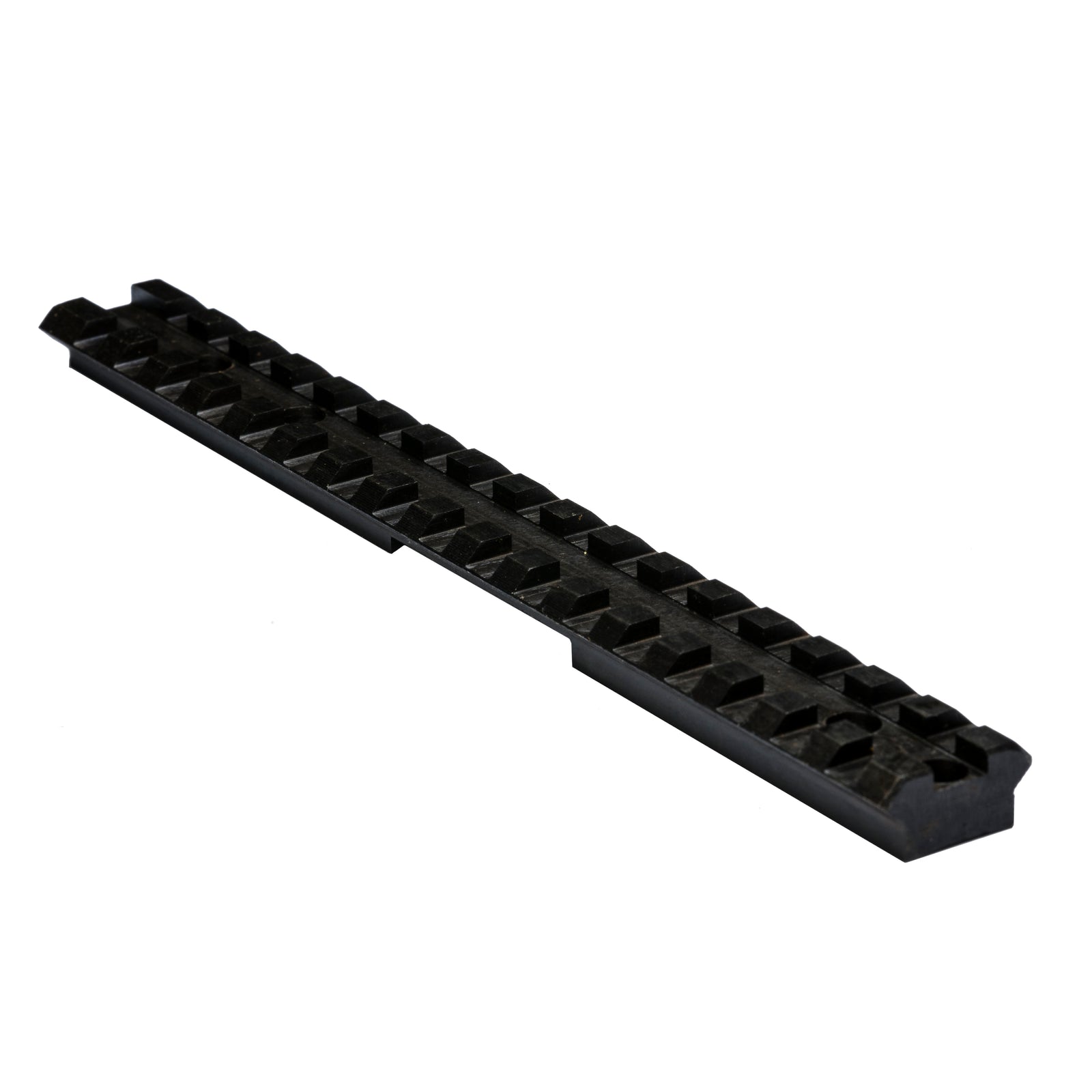The Winchester 1873 isn't the most accurate nor does it fire the strongest cartridges. Actually, when you look down at the chamber, you’ll notice the face of the bolt doesn’t even quite reach the mouth of the chamber, leaving a visible gap for the rim.
What it does have, that many other rifles at the time of its creation did not, was repeating firepower of great speed. You can put more than a dozen rounds down range in less than a minute, and it has a magazine that can hold those rounds. While that doesn’t sound too fancy nowadays, you have to consider that this rifle is not far off from being a century and a half old in design.
Yet it doesn’t look a day over 44.
The story of this rifle is not one of startling, ground sweeping change. Instead, it was a series of well-made decisions that boosted this rifle to great popularity, at a time when people in the Wild West were looking for a rifle just like it.
Iron (then steel) receiver. Magazine. More reliable, stronger cartridge meant to reach 150 yards. Cartridge that also became popular in handguns. Rifle is well-made. Capable of being fixed in the field, as that knife story shows. Not incredibly precise, but precise enough for hunting and fighting accuracy.
Let’s dig into the history

Pre-1873 Rifle Design
Like any major leap in firearms, the Winchester 1873 relies on many advancements from its predecessors - and, to keep things interesting, has unique personal touches from some of the biggest names in firearms design.
The first solid roots of the Winchester 1873 design start more than two decades earlier. In 1849, Walter Hunt patented the Volition Repeating Rifle. In reality, he applied for the patent a full two years earlier, but that’s a story for another time. From this rifle, the later Winchester draws two key features: a tubular magazine under the barrel, and a lever that cycles the action and loads rounds into the chamber. Hunt’s design was decisively inventive at the time, though a bit weighty and difficult to manufacture. The original design for the Hunt Volitional Rifle had a 12-round .54 caliber magazine under the barrel. It fired Rocket Ball ammunition, which has fallen out of favor since the advent of centerfire ammunition.
The Volitional Rifle was difficult enough to manufacture that it never went into production. The only known example is a prototype. Hunt sold his design to another gun designer, Robbins & Lawrence, who hired Lewis Jennings to work on the design. Jennings went on to patent a bevy of improvements, and managed to sell perhaps a thousand rifles over a couple years. His rifle could hold 24 rounds, though it was underpowered.
Hunt’s earlier rifle and Jenning’s later, improved model both fired rocket balls (also known as a volition ball). These rounds had a propellant change in a hollow part of the bullet, which needed to be set off by a percussion cap. Jenning’s potentially greatest improvement to Hunt’s original design was the inclusion of a magazine of percussion caps. This magazine was built into the receiver. When the action cycled, a bullet (with powder and a paper patch) was loaded from the tubular magazine. Simultaneously, a cap was automatically placed in position. A single trigger pull was in charge of all these actions, along with the final act of firing. This rifle had a trigger ring, instead of a now-standard lever-like trigger. Pulling this trigger ring part way would cycle the action, and pulling the trigger ring the remaining travel distance would cause the rifle to fire.
Ultimately, the rifle was a curio with little practical use. It wasn’t powerful enough for hunting or warfare, and the special bullets were largely to blame. These rifles were only manufactured from 1850-1851. When the repeater version of the Jennings Breech-Loading Rifle lost interest, the existing rifles in inventory were converted to single-shot breech loaders.
During the development of Jennings' Rifle, we see another familiar name pop up: Benjamin Tyler Henry. Henry was employed by Robbins & Lawrence, the same gun manufacturers who purchased Hunt’s design and employed Jennings. In fact, Henry was a gunsmith and foreman at one of the Lawrence factories.

The Robbins & Lawrence factories around this time were operating on the forefront of precision machining and interchangeable parts. The gunsmithing machines were sometimes bought and other times designed and built by the partners. These machines operated on water power from the local dam, using overhead belts and drive shafts connected down to the machines. Skilled labor was brought in from Springfield Armory, Eli Whitney, and other manufacturing sources, while unskilled labor often happened at factories built in prisons. The shift in production from handmade rifles to repeatable, interchangeable parts proved to be so efficient that the company completed their first large military order 18 months ahead of schedule, a few years before the Jennings rifle ever entered the picture.
A while after the Jennings Repeaters fell to the side, two more investors stepped in with interest: Horace Smith and Daniel Wesson, eventually of Smith & Wesson. The pair formed the Volcanic Repeating Arms Company in 1854. They produced an update to the repeater that would forever go down in history - the lever action. Now the lever would be responsible for loading, while a separate trigger would be responsible for firing. Their Volcanic design was offered in both rifle and pistol formats.
Ultimately, the Volcanic’s design also suffered the drawbacks of the rocket ball system - namely, underpowered ammunition. Smith and Wesson would sell their company in 1855, to a group led by Oliver Winchester.
Fairly soon, Winchester renamed his company to the New Haven Arms Company. In that year, 1857, he also hired Benjamin Tyler Henry to be the factory foreman. Henry quickly abandoned the rocket ball ammunition, switching the rifle design to the more powerful .44 caliber rimfire of the time. Henry’s designs were awarded patents in 1860, though it was the imminent Civil War that helped his designs grow in popularity.
Troops on both sides of the line used Henry’s rifles. While they were more common among Union troops, even Confederate President Jefferson Davis had his bodyguards armed with captured Henry Repeating Rifles. The Union Army officially purchased 1,731 Henry rifles, while another 9,000 entered general circulation among civilians. The Henry’s 16-round tubular magazine gained it a reputation for firepower at a time where the more common Spencer Repeaters had a 7-round magazine. It was said you could load the rifle on a Sunday and shoot through the rest of the week.
In 1866, Oliver Winchester renamed the company after himself. Winchester Repeating Arms Company was born, bringing with it the new Model 1866. The 1866 was an update to Henry’s design, now incorporating a loading gate in the receiver. It also featured a wooden hand guard of new design. Combining these new qualities, the rifleman’s hand was protected from the heat of the muzzle, both during use and when loading the rifle. Black powder heats up a barrel remarkably quickly, and firing shots in rapid succession even more so. As simple as it was, a hand guard was a new necessity - and necessity was most certainly the mother of this invention.

1873 Initial Design and Build
Seven years after the Winchester 1866 design, we finally get to see the New Model of 1873. No longer using rimfire ammunition, the Winchester 1873 was configured to fire Winchester’s new .44-40 centerfire cartridges. It retained the same toggle-link action as the Henry rifle, with the necessary modifications to change the striker from a rim position to the center.
The toggle link action works somewhat oddly compared to more modern arms. Pushing the lever forward (down) slides the breech block out of battery and extracts the spent case. Continuing to push the lever forward would lift a new cartridge into place. Finally, returning the lever to a closed position slides the breech block forward and back into place. Sliding the breech block also chambers the next round and cams the toggle joint into the locked position.
The 1873’s toggle link action would later prove to be an impediment to using stronger cartridges. For the time in which it came to be (and for many decades after), it still proved to be immensely popular. While the .44-40 cartridge, with a .44 caliber bullet and 40 grains of black powder, wasn’t incredibly powerful, it was powerful enough. The 200 grain bullet achieved velocities of 1200 fps. The bullet’s flat face was likely a result of the same phenomena that plagued tube-fed .45-70 rifles: a sharp nose on a bullet would set off the primer of the next round in line when the rifle fired. Simultaneously, the flat nose made the functioning of a revolver that much easier.
As an added bonus, many of the revolvers of the time were also being chambered for the same round. It was said that “the 1873 rifle could be used for anything between 150 yards and arm’s length, while the revolver was meant for anything closer”. (I’m not sure if this is meant to be a crack about that era’s revolver accuracy or not... but the point stands)
Even at a time where other single shot rifles were firing more powerful buffalo cartridges, the 1873 and its comparatively weak cartridge remained popular. The large magazine and ability to place rapid shots down range proved to be more important than firing a single show-stopping round. It was large enough to hunt most game, and certainly powerful enough for combat.

The 1873 was considered completely reliable. In one story from 1881 (or 1875, by other accounts), a Texas Ranger named George Lloyd loaded the wrong cartridge in his 1873. Rather than the .44-40 it was meant for, he loaded a .45 Long Colt, which ended up jamming the rifle. In the heat of battle, he used a knife to unscrew the side plate of the rifle and then pry out the case. Finally, after taking the time to reattach the side plate, he resumed combat - and lived long enough to tell the tale.
It’s said that many of the biggest names in the Wild West carried this rifle. Buffalo Bill carried a Model 1873 and a pair of Colts (all with matching ammo) when he scouted for the Army in 1876. Forensic research has revealed that Native Americans had 8 of these rifles at the Battle of the Little Bighorn in 1876. Jesse James’ brother Frank also carried an 1873.
While the 1873 proved to be popular among Texas Rangers, the military never officially adopted the rifle. A few concerns were raised - the cartridge was weaker than the then-popular .45-70, economic constraints prevented large scale purchasing, and there was a policy in place against repeating arms. It was thought that big magazines would encourage the waste of ammunition. Still, many officers serving in the west privately purchased these arms for their own use.
As time went on, Winchester offered different versions of his popular lever action. The rifle was rechambered to fit new cartridges, such as the .38 WCF (in 1874) and .32 WCF (in 1882). The standard version of the .44-40 rifle had a 24 inch octagonal barrel. Round-barreled 20 inch carbines were also made, as were variations with pistol grips, engravings, and odd barrel lengths.
Special versions of the rifle titled “One of One Thousand” were outfitted with more accurate barrels, set triggers, fancy wood, and engravings. These were highly sought out by shooters of the time, despite the high price tag. Little more than 100 of these special edition 1873s were made. Nowadays, the modern take on “One of One Thousand” quality rifles can be found through the Taylor’s Tuning process. This tuning method takes a standard 1873 and improves it through hand polishing the action, installing custom hammer and lever springs, custom magazine tube springs, and topping it off an overall lightened action
1873 After Release
In 1885, John Moses Browning was asked to design a stronger action that could fire higher-pressure cartridges such as the .50-110 Winchester. Browning’s designs came together to form the Winchester Model 1886. The 1886 featured a vertically sliding, locking-block action that replaced the weaker toggle-link action in use through the Model 1873. Browning’s action would go on to sell more than 8 million lever-action rifles of the 1886, 1892, and 1894 models.
Winchester continued manufacturing the Model 1873 until about 1919 (or 1923, depending on your sources). In all, 720,610 of the rifles were made during that time.

Conclusion
It’s no surprise that the Winchester Model 1873 was known as “the gun that won the west.” With its many changes to the firearms industry and a pedigree lineage, this rifle brought together nearly thirty years of colossal change. Henry, Winchester, and Smith & Wesson combined all the right qualities to eventually craft a rifle capable of capturing the interests of the still-young country. Bringing together a repeating lever action, centerfire ammunition, a tubular magazine, a hand guard, and a receiver gate, their designs live on in the many rifles that have been crafted since.
Also, it’s darn fun to shoot. So there’s that.





Leave a comment (all fields required)